Systems and methods for enhancing communication network performance using vector based deep learning
Staple , et al. April 12, 2
U.S. patent number 11,303,348 [Application Number 16/886,154] was granted by the patent office on 2022-04-12 for systems and methods for enhancing communication network performance using vector based deep learning. This patent grant is currently assigned to Ball Aerospace & Technologies Corp.. The grantee listed for this patent is Ball Aerospace & Technologies Corp.. Invention is credited to Jennifer H. Lee, Jason Monin, Bevan D. Staple, Cynthia Wallace.
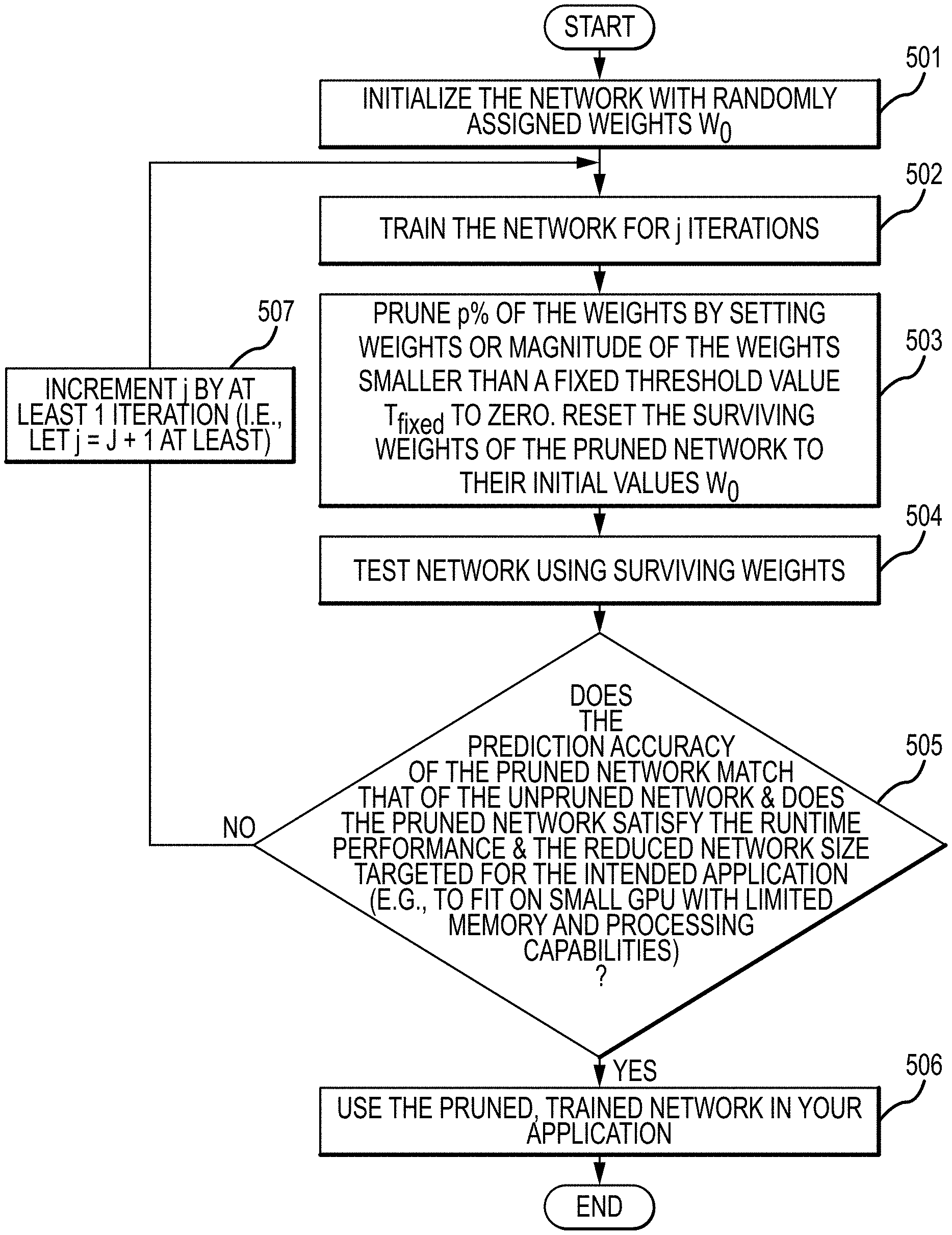
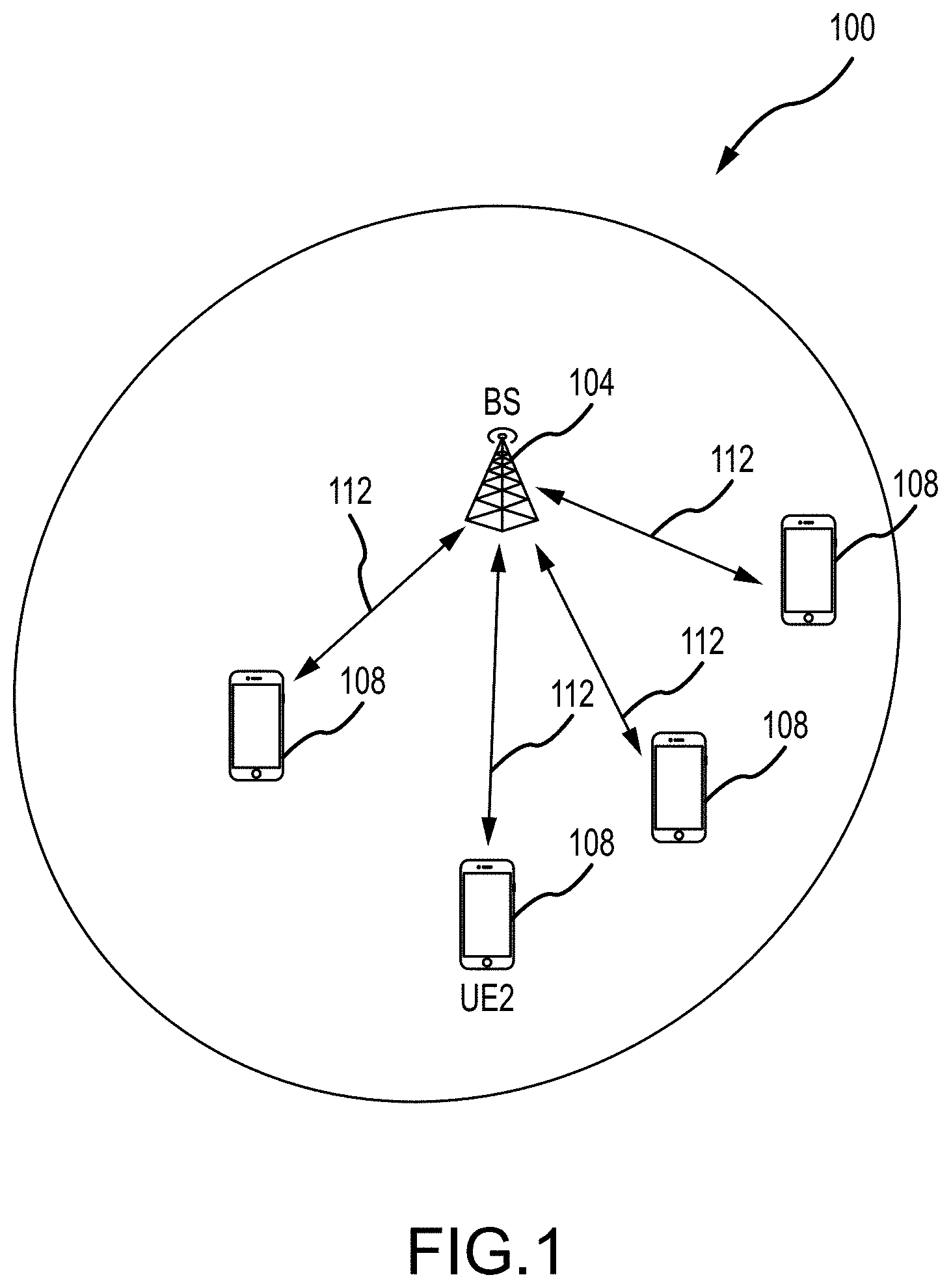

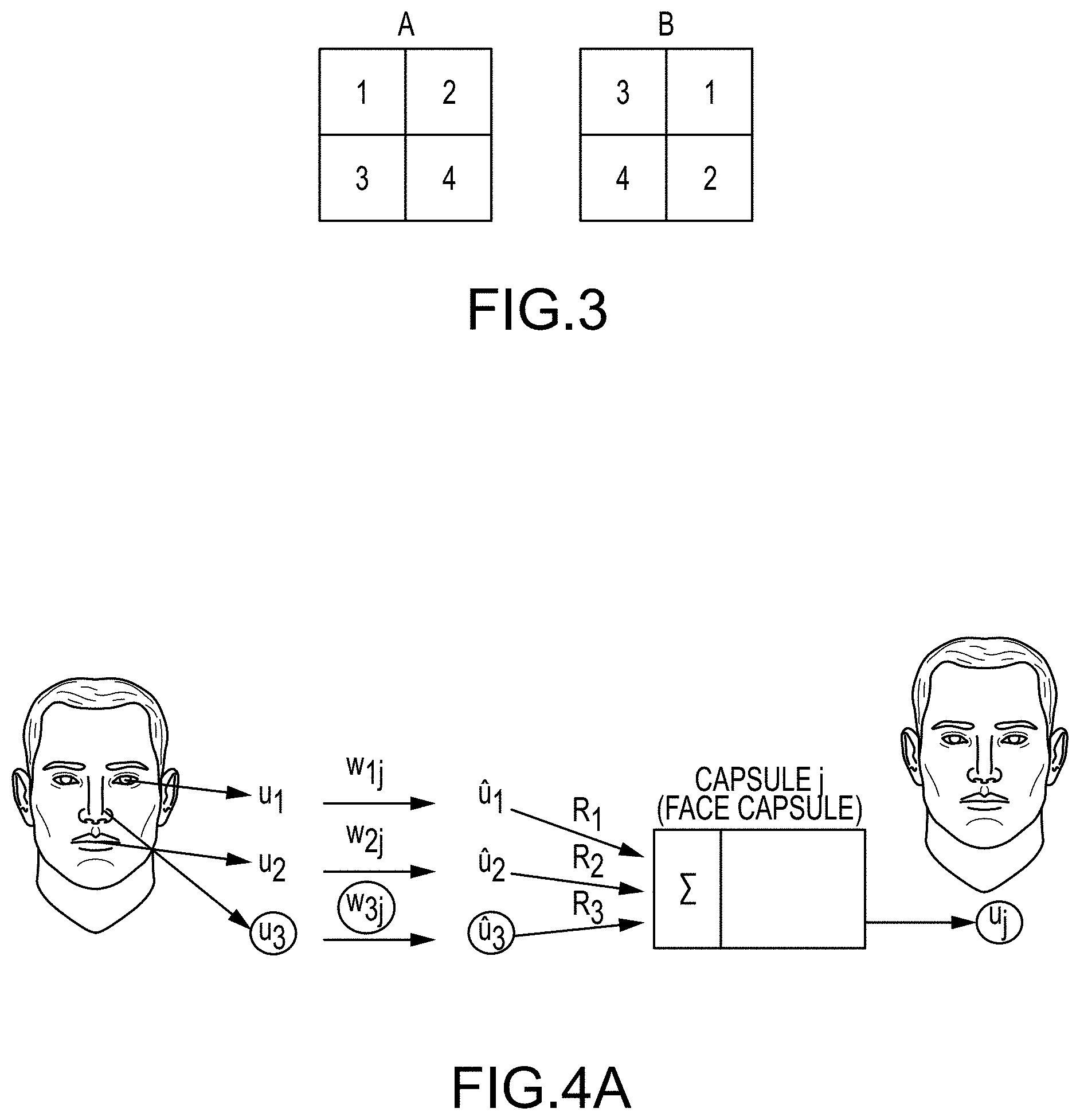


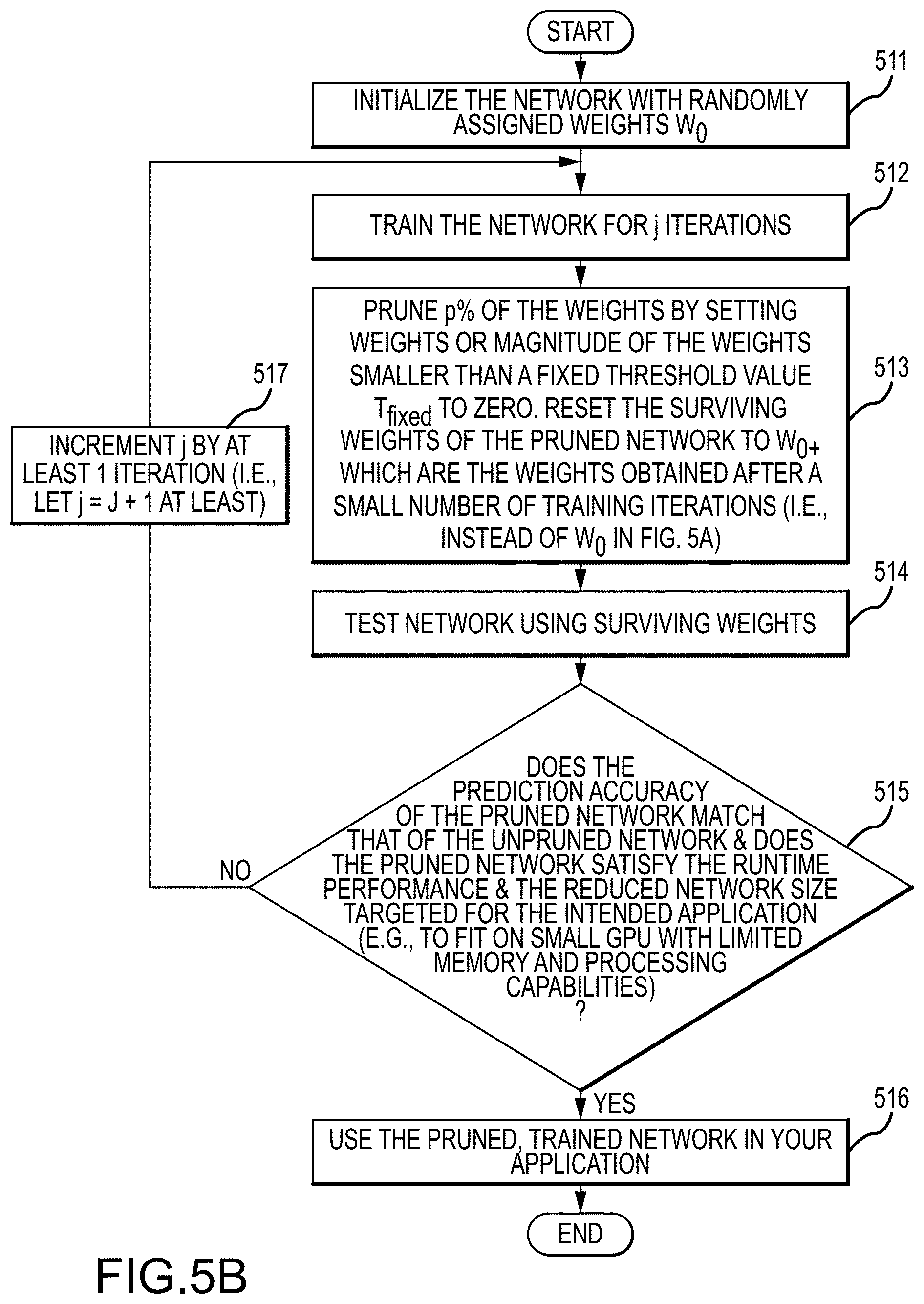
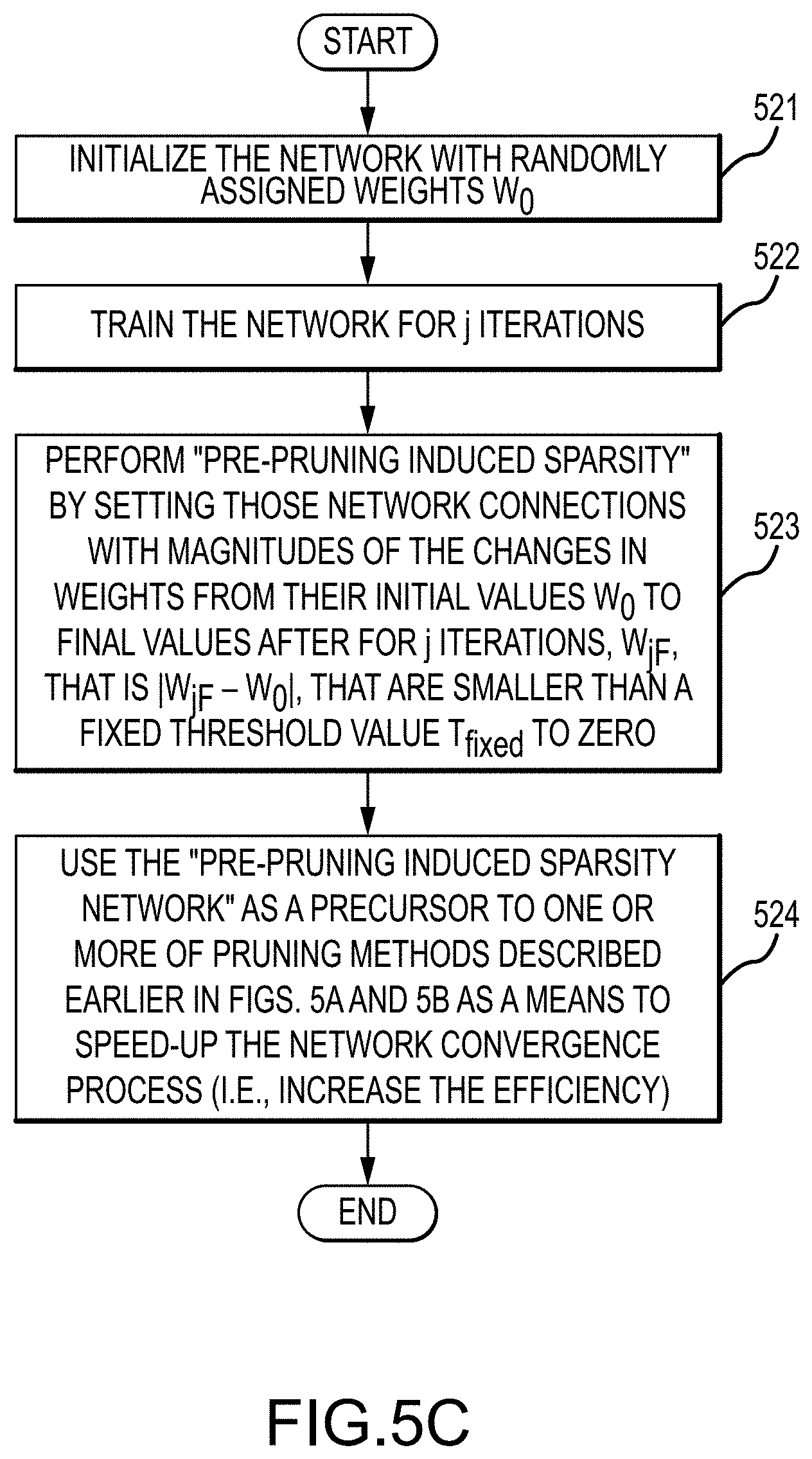
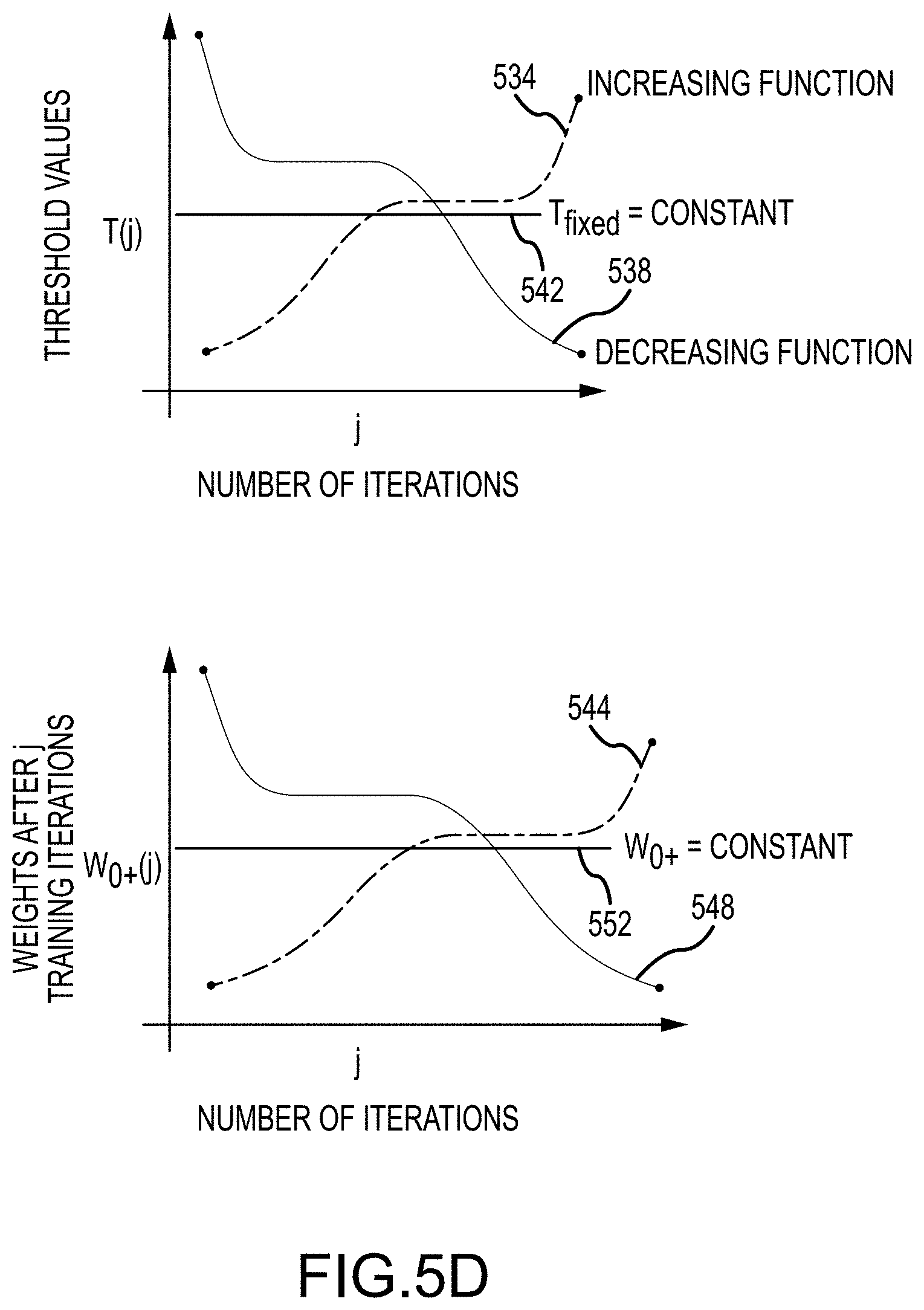
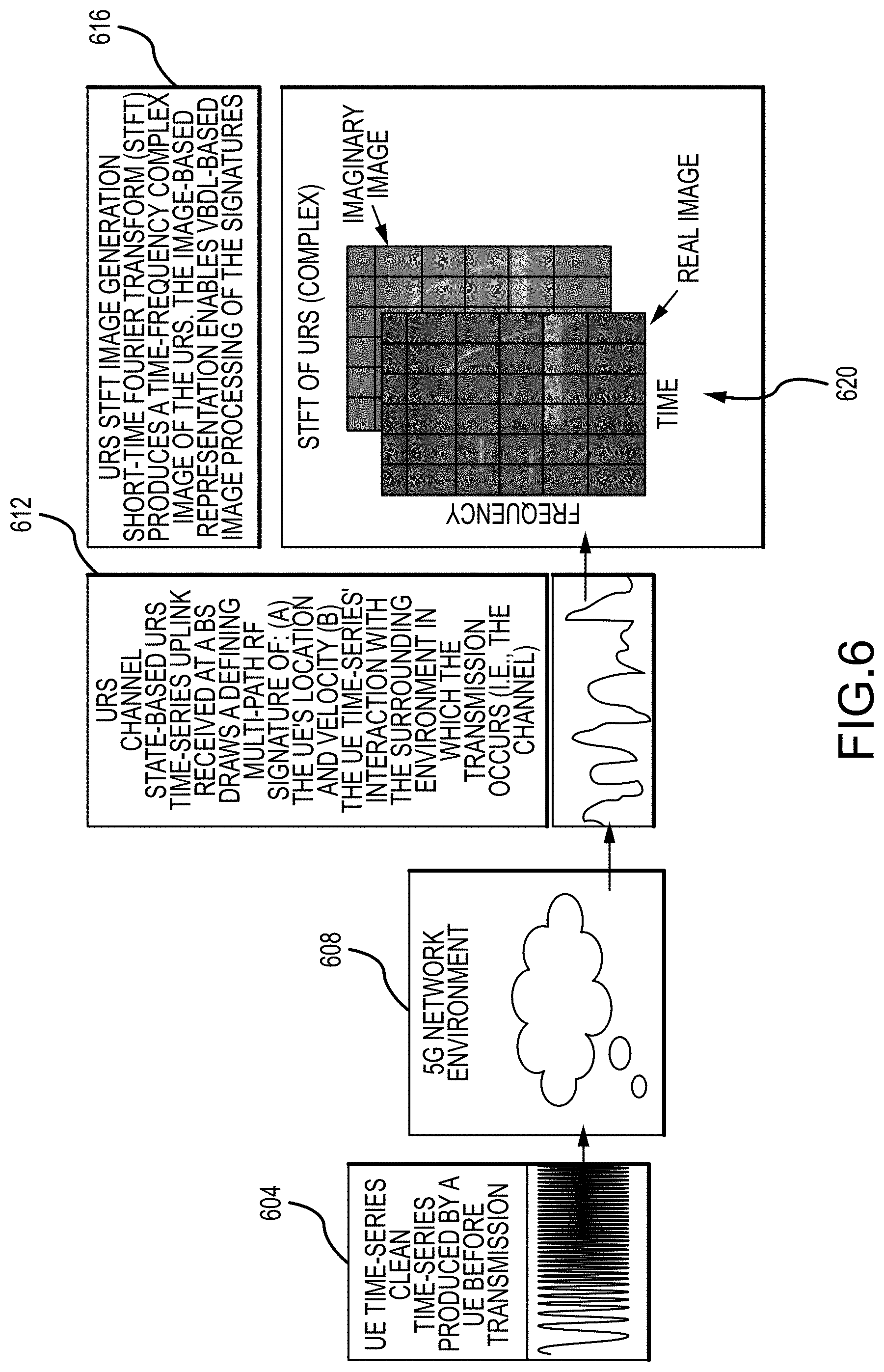
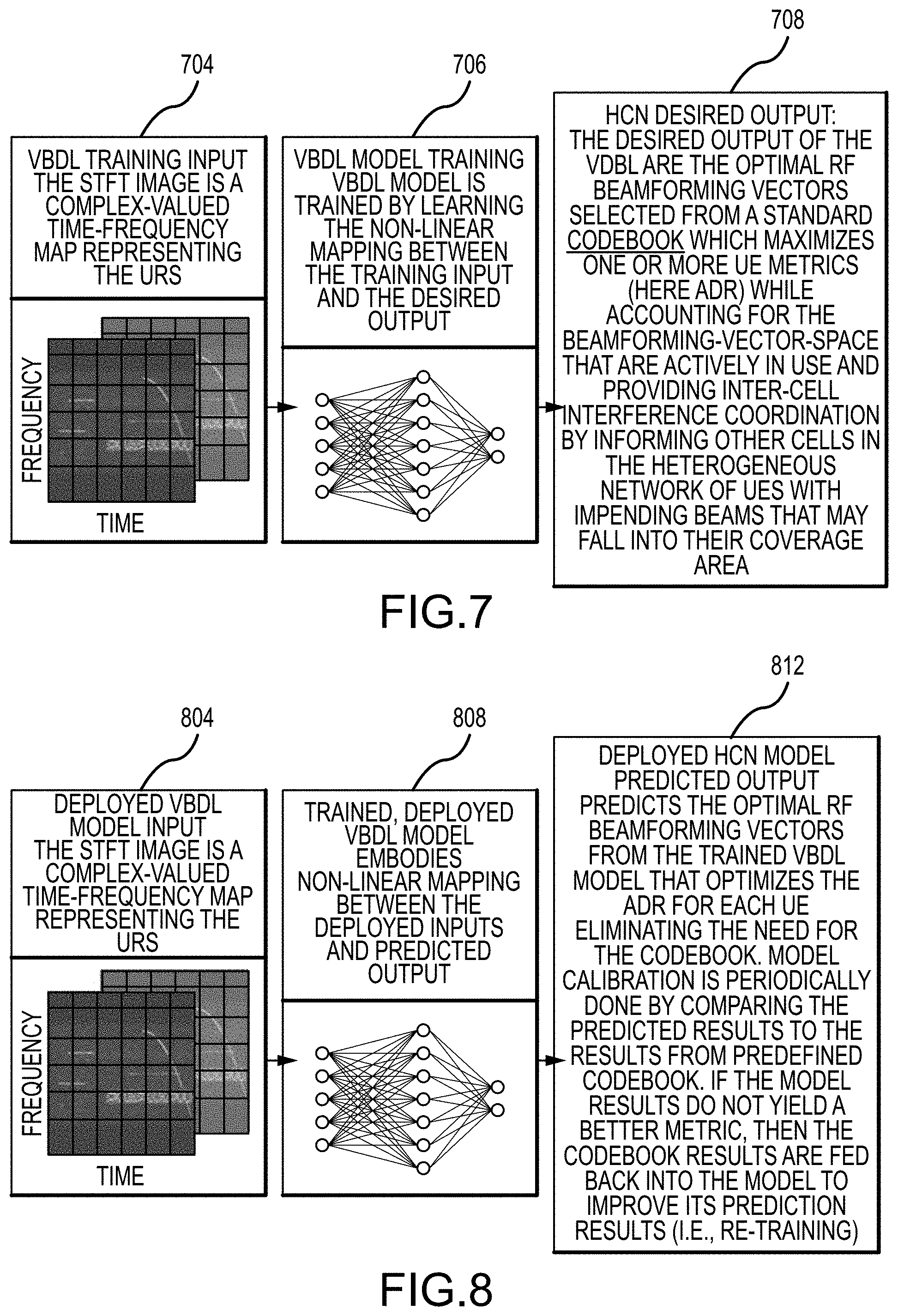
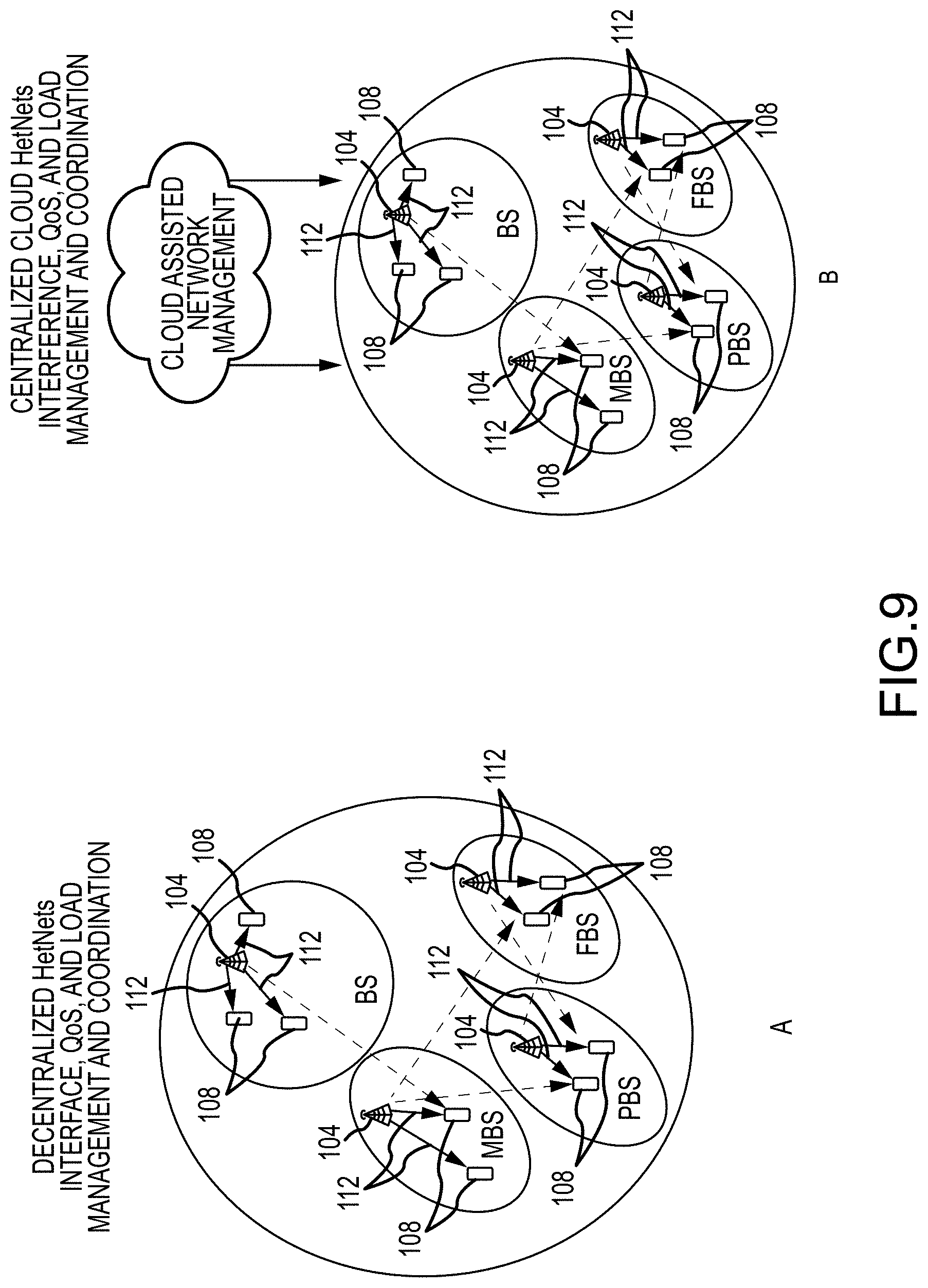
View All Diagrams
| United States Patent | 11,303,348 |
| Staple , et al. | April 12, 2022 |
Systems and methods for enhancing communication network performance using vector based deep learning
Abstract
Systems and methods for forming radio frequency beams in communication systems are provided. Signals from one or more devices are received at a base station and are processed using a vector based deep learning (VBDL) model or network. The VBDL model can receive and process vector and/or spatial information related to or part of the received signals. An optimal beamforming vector for a received signal is determined by the VBDL model, without reference to a codebook. The VBDL model can incorporate parameters that are pruned during training to provide efficient operation of the model.
| Inventors: | Staple; Bevan D. (Longmont, CO), Lee; Jennifer H. (Boulder, CO), Monin; Jason (Dayton, OH), Wallace; Cynthia (Louisville, CO) | ||||||||||
|---|---|---|---|---|---|---|---|---|---|---|---|
| Applicant: |
|
||||||||||
| Assignee: | Ball Aerospace & Technologies
Corp. (Boulder, CO) |
||||||||||
| Family ID: | 1000004942032 | ||||||||||
| Appl. No.: | 16/886,154 | ||||||||||
| Filed: | May 28, 2020 |
Related U.S. Patent Documents
| Application Number | Filing Date | Patent Number | Issue Date | ||
|---|---|---|---|---|---|
| 62854152 | May 29, 2019 | ||||
| Current U.S. Class: | 1/1 |
| Current CPC Class: | G06N 3/082 (20130101); H04B 7/086 (20130101); G06N 3/0454 (20130101) |
| Current International Class: | H04B 7/08 (20060101); G06N 3/08 (20060101); G06N 3/04 (20060101) |
References Cited [Referenced By]
U.S. Patent Documents
| 5588073 | December 1996 | Lee et al. |
| 5636326 | June 1997 | Stork |
| 5719794 | February 1998 | Altshuler et al. |
| 5960391 | September 1999 | Tateishi et al. |
| 6075991 | June 2000 | Raleigh et al. |
| 6252627 | June 2001 | Frame et al. |
| 6437692 | August 2002 | Petite et al. |
| 6597394 | July 2003 | Duncan et al. |
| 6820053 | November 2004 | Ruwisch |
| 7020501 | March 2006 | Elliott et al. |
| 7590098 | September 2009 | Ganesh |
| 8019544 | September 2011 | Needelman et al. |
| 8583371 | November 2013 | Goodzeit et al. |
| 8929936 | January 2015 | Mody et al. |
| 9073648 | July 2015 | Tsao et al. |
| 9191587 | November 2015 | Wright et al. |
| 9294365 | March 2016 | Misra et al. |
| 9449374 | September 2016 | Nash et al. |
| 9702702 | July 2017 | Lane et al. |
| 9924522 | March 2018 | Gulati et al. |
| 9927510 | March 2018 | Waldron et al. |
| 10021313 | July 2018 | Chen et al. |
| 10048084 | August 2018 | Laine et al. |
| 10271179 | April 2019 | Shima |
| 10726830 | July 2020 | Mandal |
| 10879946 | December 2020 | Shima |
| 10970520 | April 2021 | Kim et al. |
| 11182672 | November 2021 | Schmidt |
| 2005/0049876 | March 2005 | Agranat |
| 2005/0228660 | October 2005 | Schweng |
| 2006/0030332 | February 2006 | Carrott et al. |
| 2007/0010956 | January 2007 | Nerguizian et al. |
| 2008/0020354 | January 2008 | Goree et al. |
| 2008/0045235 | February 2008 | Kennedy et al. |
| 2008/0293353 | November 2008 | Mody et al. |
| 2009/0179142 | July 2009 | Duparre et al. |
| 2009/0197550 | August 2009 | Huttunen et al. |
| 2009/0268619 | October 2009 | Dain et al. |
| 2010/0091017 | April 2010 | Kmiecik et al. |
| 2012/0071105 | March 2012 | Walker et al. |
| 2012/0072986 | March 2012 | Livsics et al. |
| 2012/0163355 | June 2012 | Heo et al. |
| 2012/0167144 | June 2012 | Avison-Fell |
| 2012/0202510 | August 2012 | Singh |
| 2012/0238201 | September 2012 | Du et al. |
| 2012/0238220 | September 2012 | Du et al. |
| 2014/0218520 | August 2014 | Teich et al. |
| 2014/0232871 | August 2014 | Kriel et al. |
| 2014/0282783 | September 2014 | Totten et al. |
| 2014/0329540 | November 2014 | Duggan et al. |
| 2015/0009072 | January 2015 | Nijsure |
| 2016/0101779 | April 2016 | Katoh |
| 2016/0173241 | June 2016 | Goodson et al. |
| 2016/0187477 | June 2016 | Wang |
| 2017/0120906 | May 2017 | Penilla et al. |
| 2017/0123429 | May 2017 | Levinson et al. |
| 2017/0366264 | December 2017 | Riesing et al. |
| 2018/0019910 | January 2018 | Tsagkaris et al. |
| 2018/0025641 | January 2018 | LaVelle et al. |
| 2018/0033449 | February 2018 | Theverapperuma |
| 2018/0053108 | February 2018 | Olabiyi et al. |
| 2018/0082438 | March 2018 | Simon et al. |
| 2018/0107215 | April 2018 | Djuric et al. |
| 2018/0149730 | May 2018 | Li et al. |
| 2018/0268571 | September 2018 | Park et al. |
| 2018/0293893 | October 2018 | Yang et al. |
| 2018/0324595 | November 2018 | Shima |
| 2019/0049955 | February 2019 | Yabuuchi et al. |
| 2019/0066713 | February 2019 | Mesgarani et al. |
| 2019/0122689 | April 2019 | Jain et al. |
| 2019/0164430 | May 2019 | Nix |
| 2019/0213887 | July 2019 | Kitayama et al. |
| 2019/0294108 | September 2019 | Ozcan et al. |
| 2019/0318725 | October 2019 | Le Roux et al. |
| 2019/0322282 | October 2019 | Theodosis et al. |
| 2019/0353741 | November 2019 | Bolster, Jr. et al. |
| 2019/0363430 | November 2019 | Wang et al. |
| 2020/0327397 | October 2020 | Govea |
| 2020/0335121 | October 2020 | Mosseri |
| 108875595 | Nov 2018 | CN | |||
Other References
|
Official Action for U.S. Appl. No. 16/668,826, dated Jul. 28, 2020 11 pages. cited by applicant . U.S. Appl. No. 16/597,411, filed Oct. 9, 2019, Schmidt et al. cited by applicant . U.S. Appl. No. 16/668,826, filed Oct. 30, 2019, Shima. cited by applicant . U.S. Appl. No. 16/693,992, filed Nov. 25, 2019, Tchilian. cited by applicant . U.S. Appl. No. 16/745,725, filed Jan. 17, 2020, Tchilian et al. cited by applicant . U.S. Appl. No. 16/806,367, filed Mar. 2, 2020, Frye et al. cited by applicant . U.S. Appl. No. 16/886,983, filed May 29, 2020, Regan. cited by applicant . "Deep Learning Meets DSP: OFDM Signal Detection," KickView Tech Blog, Feb. 13, 2018, 25 pages [retrieved online from: blog.kickview.com/deep-learning-meets-dsp-ofdm-signal-detection/]. cited by applicant . Buchheim "Astronomical Discoveries You Can Make, Too!" Springer, 2015, pp. 442-443. cited by applicant . Ma et al. "Attitude-correlated frames approach for a star sensor to improve attitude accuracy under highly dynamic conditions," Applied Optics, Sep. 2015, vol. 54, No. 25, pp. 7559-7566. cited by applicant . Ma et al. "Performance Analysis of the Attitude-correlated Frames Approach for Star Sensors," IEEE, 3rd IEEE International Workshop on Metrology for Aerospace (MetroAeroSpace), Firenze, Italy, Jun. 22-23, 2016, pp. 81-86. cited by applicant . Nair et al. "Accelerating Capsule Networks with Tensor Comprehensions," Princeton, May 2018, 8 pages. cited by applicant . Ni et al. "Attitude-correlated frames adding approach to improve signal-to-noise ratio of star image for star tracker," Optics Express, May 2019, vol. 27, No. 11, pp. 15548-15564. cited by applicant . Wang "Research on Pruning Convolutional Neural Network, Autoencoder and Capsule Network," before Oct. 9, 2018, 11 pages. cited by applicant . Wang et al. "An Optimization View on Dynamic Routing Between Capsules," ICLR 2018 Workshop, Feb. 2018, 4 pages. cited by applicant . Official Action for U.S. Appl. No. 15/973,022, dated Oct. 9, 2018 16 pages. cited by applicant . Notice of Allowance for U.S. Appl. No. 15/973,022, dated Feb. 20, 2019 10 pages. cited by applicant . Official Action for U.S. Appl. No. 15/973,003, dated Mar. 20, 2020 35 pages. cited by applicant . Official Action for U.S. Appl. No. 16/668,826, dated Mar. 3, 2020 10 pages. cited by applicant . Gu et al. "Continuous Deep Q-Learning with Model-based Acceleration," Proceedings of Machine Learning Research, vol. 48, 2016, pp. 2829-2838. cited by applicant . Happel et al. "The Design and Evolution of Modular Neural Network Architectures," Neural Networks, 1994, vol. 7, pp. 985-1004. cited by applicant . JOHNSON "Orbital Debris: The Growing Threat to Space Operations," 33rd Annual Guidance and Control Conference, Feb. 6, 2010, Breckenridge, CO, United States. cited by applicant . Peng et al. "Improving Orbit Prediction Accuracy through Supervised Machine Learning,". cited by applicant . Taylor "Transfer Learning for Reinforcement Learning Domains: A Survey," Journal of Machine Learning Research, 2009, vol. 10, pp. 1633-1685. cited by applicant . Watkins "Learning from Delayed Rewards," King's College, May 1989, Thesis for Ph.D., 241 pages. cited by applicant . Goodfellow et al. "Deep Learning," MIT Press, 2016, 796 pages [retrieved online from: www.deeplearningbook.org]. cited by applicant . Official Action for U.S. Appl. No. 15/973,003, dated Oct. 21, 2020 31 pages. cited by applicant . Notice of Allowance for U.S. Appl. No. 16/668,826, dated Nov. 3, 2020 5 pages. cited by applicant. |
Primary Examiner: Bilodeau; David
Attorney, Agent or Firm: Sheridan Ross P.C.
Parent Case Text
CROSS-REFERENCE TO RELATED APPLICATIONS
This application claims the benefit of U.S. Provisional Patent Application Ser. No. 62/854,152, filed May 29, 2019, the entire disclosure of which is hereby incorporated herein by reference.
Claims
What is claimed is:
1. A method, comprising: receiving a time series signal; transforming the time series signal to a spectrogram of real components and a spectrogram of imaginary components of the time series signal; inputting the spectrogram of real components and the spectrogram of imaginary components of the time series signal to a vector based deep learning (VBDL) model; and using the VBDL model to predict an optimal beamforming vector.
2. The method of claim 1, wherein the VBDL model implements a pruned Hinton's capsule network.
3. The method of claim 1, wherein the VBDL model implements a coordinate convolution model that includes first and second Cartesian coordinates as inputs.
4. The method of claim 1, further comprising: forming a beam of a phased array antenna by applying the predicted optimal beam forming vector, wherein the VBDL model is trained with reference to a beamforming codebook, and wherein the VBDL model outputs a predicted optimal beamforming vector without reference to the beamforming codebook.
5. The method of claim 1, further comprising: pruning the VBDL model, wherein weights that are less than a threshold value are pruned from the VBDL model.
6. The method of claim 5, wherein the threshold value is varied according to a first function.
7. The method of claim 5, wherein pruning the VBDL model includes: assigning random values to a set of weights; training the VBDL model until it converges; pruning p % of the weights; resetting the weights remaining after the pruning to the initially assigned values; training the VBDL model using the reset weights until the model converges; and using the trained VBDL model to predict an optimal beamforming vector.
8. The method of claim 7, further comprising: comparing the performance of the trained VBDL model to the unpruned VBDL model; applying the trained VBDL model if the performance is close that of the unpruned VBDL model; and applying the unpruned VBDL model if the performance is not close to that of the unpruned VBDL model.
9. The method of claim 5, wherein pruning the VBDL model includes: assigning random values to a set of weights; training the VBDL model until it converges; pruning p % of the weights; resetting the weights remaining after the pruning to the initially assigned values; iteratively training the VBDL model using the reset weights for a selected number of iterations; and using the trained VBDL model to predict an optimal beamforming vector.
10. The method of claim 9, further comprising: comparing the performance of the trained VBDL model to the unpruned VBDL model; applying the trained VBDL model if the performance is close that of the unpruned VBDL model; and applying the unpruned VBDL model if the performance is not close to that of the unpruned VBDL model.
11. A system, comprising: an antenna; a beamforming network coupled to the antenna; a transceiver coupled to the beamforming network; a processor, the processor configured to: implement a vector based deep learning (VBDL) model, wherein a time series signal received at the antenna and passed through the beamforming network and the transceiver to the processor is transformed into a spectrogram of real components and a spectrogram of imaginary components of the time series signal, and wherein the spectrogram of real components and the spectrogram of imaginary components of the time series signal are input to the VBDL model; output from the VBDL model a predicted optimum beamforming vector for the time series signal received at the antenna; and apply the predicted optimum beamforming vector to form an antenna beam by controlling the beamforming network.
12. The system of claim 11, wherein at least the antenna, the beamforming network, and the transceiver are part of a communication system base station.
13. The system of claim 12, wherein the communication system is a 5G communication system.
14. The system of claim 11, wherein the processor is further configured to: prune the VBDL model.
15. The system of claim 14, wherein pruning the VBDL model includes: assigning random values to a set of weights; training the VBDL model until it converges; pruning p % of the weights; resetting the weights remaining after the pruning to the initially assigned values; training the VBDL model using the reset weights until the model converges; and using the trained VBDL model to predict an optimal beamforming vector.
16. The system of claim 15, wherein the processor is further configured to: compare the performance of the trained VBDL model to the unpruned VBDL model; apply the trained VBDL model if the performance is close that of the unpruned VBDL model; and apply the unpruned VBDL model if the performance is not close to that of the unpruned VBDL model.
17. The system of claim 14, wherein pruning the VBDL model includes: assigning random values to a set of weights; training the VBDL model until it converges; pruning p % of the weights; resetting the weights remaining after the pruning to the initially assigned values; iteratively training the VBDL model using the reset weights for a selected number of iterations; and using the trained VBDL model to predict an optimal beamforming vector.
18. The system of claim 17, wherein the processor is further configured to: compare the performance of the trained VBDL model to the unpruned VBDL model; apply the trained VBDL model if the performance is close that of the unpruned VBDL model; and apply the unpruned VBDL model if the performance is not close to that of the unpruned VBDL model.
Description
FIELD
Communication systems and methods in which vector based deep learning is applied for enhanced performance are provided.
BACKGROUND
5G millimeter wave (mmWave) systems promise a paradigm of higher bandwidth and thus greater connectivity over previous networks. However, 5G brings several challenges, including higher path losses experienced by 5G mmWaves from obstructions and the atmosphere that are inherent to the frequencies used by 5G systems (28-39 GHz). To address the path loss issues, 5G communication cells are smaller as compared to systems that operate at lower frequencies, and beamforming strategies are often employed for transmitter-to-receiver efficiency. As a result, the need for complex signal routing and frequent hand-off of signals between base stations (BS) can lead to safety critical impacts to quality of service (QoS) and latency (e.g., for autonomous cars). Furthermore, beamforming (that is, establishing the proper signal routing instructions) requires considerable training overhead when using predefined codebooks. In addition, 5G heterogeneous networks (HetNets) comprise a mixture of base stations and their lower-tier companions (such as micro base stations (MBS), pico base stations (PBS), femto base stations (FBS), and remote radio heads (RRH)), as well as a multitude of user equipment (UE) served by these BSs. Such HetNets suffer from significant co-channel and intra-cell interference, impacts to achievable data rate (ADR), and load balancing (LB) coordination challenges.
Alkhateeb et al, "Deep Learning Coordinated Beamforming for Highly-Mobile Millimeter Wave Systems," IEEE Access, 2018, considered a single UE supported by multiple BSs. Each signal from a UE received at a BS draws a unique RF signature of a UE's location and interaction with the transmission environment. This signature, which the authors referred to as the unique RF-signal signature (URS), was used to establish beamforming vectors for transmission from a BS to UE. Using a simple 2-dimensional representation of the URS (e.g., real and imaginary) as input, Alkhateeb then employed a deep learning (DL) technique called convolutional neural networks (CNN) to learn and predict the optimum beamforming vectors at a BS that optimized a UE's ADR. The 2D representation of the URS exploited the CNN's strength in image recognition tasks.
Systems such as that contemplated by Alkhateeb et al. showed that CNNs could be extremely fast and provide a 2.times. improvement in performance over the conventional codebook-search beamforming vector determination approach. The speed and performance of these CNN systems were attained by exploiting two types of CNN layers: (1) "max pooling" and (2) convolution (both of which result in some level of invariance). Max pooling is a strategy that uses the maximum value of clustered CNN nodes to reduce model complexity and enable model generalization. Convolution is the application of a convolution kernel (much like blurring) to an image. The use of these types of layers results in invariance, or a "blindness" of the network to certain transformations. For example, CNNs ignore the spatial relationships between objects in an image by assuming that different internal representations of the image (i.e., the re-positioning of objects within an image) do not change the properties of the image (i.e., the whole is viewed as invariant). While CNNs are generally effective at image classification tasks, this invariance resulting from expediency measures (such as max pooling and convolution) makes networks employing such measures prone to misclassify output results.
SUMMARY
Embodiments of the present disclosure provide systems and methods that use vector-based deep learning to improve the performance of a communications network, including but not limited to a 5G communications network. In particular, embodiments of the present disclosure employ vector based deep learning (VBDL) models. In contrast to CNNs whose efficiency strategies result in invariance, VBDL methods preserve vector information (such as object spatial relationships), which results in the model demonstrating equivariance instead. Equivariance means the model sees a transformation on the input and propagates that to yield a transformation in the output. Accordingly, VBDL approaches can improve the prediction accuracy of the prior art by overcoming various limitations of CNNs.
In an example scenario, a single BS serves multiple UE units. Embodiments of the present disclosure overcome CNN limitations of the prior-art by employing VBDL models. By employing a VBDL model to predict optimal beamforming vectors, a much higher quality result can be obtained, as this approach is not prone to the same invariance as a CNN. In accordance with at least some embodiments of the present disclosure, a VBDL model is implemented using novel methods to optimize a neural network called a Hinton capsule network (HCN). An HCN improves image-classification performance over CNNs by preserving vector-based information such as the pose (i.e., x-y position and orientation) and the relative spatial relationships of objects (i.e., parts) in an image (i.e., a whole), as well as time-dependent spatial behavior such as velocity. As such, an HCN would correctly classify images that can suffer from invariance when processed by a conventional CNN.
In accordance with further embodiments of the present disclosure, a VBDL model is implemented using novel methods to optimize a neural network called coordinate convolution (CoordConv) methods. CoordConv improves image classification accuracy of CNNs by giving standard CNN convolutional filters input a positional reference. This is done by adding at least two channels to the convolutional layer input--one for each of the Cartesian coordinates (here i and j). This additional information ensures that the CNN output is not invariant to pose, thus improving the classification accuracy. As applied in connection with at least some embodiments of the present disclosure, the CoordConv accuracy is enhanced by removing the max pooling layer and optimizing the filter size to capture the correlation between co-channel uplink signals. These enhancements will inevitably reduce the CoordConv runtime speed.
The challenge with VBDL models or approaches is that the inclusion of vector information results in high dimensional parameter space, and a much longer training time is needed. Even after the VBDL model is trained, the prediction time will be long, making it unsuitable for real-time tasks. In accordance with at least some embodiments of the present disclosure, the VBDL model is optimized for runtime performance and reduced neural network size (e.g., to fit on small devices with limited memory and processing capabilities) in real-world applications by novel pruning methods.
Additional features and advantages of embodiments of the present disclosure will become more readily apparent from the following discussion, particularly when taken together with the accompanying drawings.
BRIEF DESCRIPTION OF THE DRAWINGS
FIG. 1 depicts an example communications system scenario in which a base station serves multiple devices;
FIG. 2 depicts components of a processing system in accordance with embodiments of the present disclosure;
FIG. 3 illustrates the invariance problem that can occur with certain neural networks;
FIG. 4A depicts a Hinton's capsule network;
FIG. 4B depicts a neural network with a coordinate convolution (CoordConv) in accordance with embodiments of the present disclosure;
FIG. 5A depicts an iterative pruning process with VBDL weights reset to their initial values in accordance with embodiments of the present disclosure;
FIG. 5B depicts an iterative pruning process wherein weights are reset to revised values after a small number of training iterations in accordance with other embodiments of the present disclosure;
FIG. 5C depicts a one-shot pre-pruning induced sparsity method in accordance with other embodiments of the present disclosure;
FIG. 5D depicts the introduction of additional dynamism into the pruning or sparsity processes by letting network parameters be variables;
FIG. 6 depicts aspects of a process for producing model input in accordance with embodiments of the present disclosure;
FIG. 7 depicts aspects of a process for training a system model in accordance with embodiments of the present disclosure;
FIG. 8 depicts aspects of a process for predicting optimal beamforming vectors in accordance with embodiments of the present disclosure; and
FIG. 9 depicts example communications system scenarios in which multiple base stations serve multiple devices in accordance with embodiments of the present disclosure.
DETAILED DESCRIPTION
A communications system 100 such as may be operated in connection with embodiments of the present disclosure is depicted in FIG. 1. In this example, a single base station 104 is serving multiple devices 108. As an example, but without limitation, the communications system 100 can include a 5G communications system. The base station 104 can be capable of supporting multiple communication channels using multiple beams 112 that can be configured in various ways, including in power, pointing direction, and the like. An example of a base station 104 is a base station that includes one or more phased array antennas. The devices 108 can include any device capable of communicating with the base station, such as cellular telephones, Internet of things (IoT) devices, autonomous vehicle control systems, robotic systems, etc., also referred to herein as user equipment (UE). As discussed herein, embodiments of the present disclosure utilize vector based deep learning (VBDL) to determine or predict optimal beamforming vectors that can be utilized by the base station for supporting communications between the base station 104 and the connected devices 108.
A base station 104 can include, can be in communication with, or can otherwise be associated with a processing system 200 for implementing a VBDL model or network as described herein. Components that can be included in such a processing system 200 are depicted in FIG. 2. The processing system 200 generally includes a processor 204, memory 208, data storage 212, and a communications interface 216. In the example of FIG. 2, in which the processing system 200 is integrated with the base station 104, the processor 204 can directly control parameters of a beamforming network 220 used to send and receive communication signals via a phased array antenna 224 that includes a plurality of antenna elements 228. A transceiver 232 can also be included for receiving radio frequency signals from and providing radio frequency signals to the beam forming network and the phased array antenna 224. Alternatively, or in addition, the processor 204 can control one or more base stations 104 that are separate from the processing system 200, in which case signals and commands can be passed between the processing system and the base station or stations 104 through the communications interface 216.
The processor 204 may comprise a general purpose programmable processor, a set of processors, a field programmable gate array (FPGA), a controller, or the like. In accordance with embodiments of the present disclosure, the processor 204 is in the form of, includes, or is associated with a graphical processing unit (GPU). The GPU can be operated to efficiently process image data depicting RF signal signatures (URS) used to establish beam forming vectors in connection with a VBDL network as described herein. The processor 204 can operate to execute application programming 236 stored in the memory 208 and/or in the data storage 212. The application programming 236 can include firmware or software that implements methods in accordance with embodiments of the present disclosure, including implementing a VBDL model as described herein. In addition, the processor 204 can operate to process data, including signal signature data regarding signals passed between devices 108 and the base station 104.
The memory 208 may comprise solid-state, volatile, and/or non-volatile memory. Examples of suitable memory devices include RAM, DRAM, SDRAM, etc. The memory 208 can provide short and/or long term storage for the application programming 236, operating system software, data received from various sources, intermediate data products, beamforming code book data, and calculated data. The data storage 212 may comprise a hard disk drive, solid-state drive, solid-state memory, or other device for the storage of application programming and data.
The communication interface 216 may support communications between the processing system 200 and other systems. For example, the processing system 200 may be in communication with one or more base stations 104, another processing system 200, a network authority, or the like, via the communication interface 216. As examples, but without limitation, the communication interface 216 can include an Ethernet interface, a microwave communication interface, a satellite communication interface, a WiFi interface, a fiber optic network interface, or the like.
The beamforming network 220 generally includes feed lines for carrying signals between individual antenna elements 228 of the phased array antenna 224 and the transceiver 232. The beamforming network 220 can further include, phase shifters, amplifiers, delay lines, attenuators, and the like, at least some of which are variable. As can be appreciated by one of skill in the art after consideration of the present disclosure, by selectively controlling the elements of the beamforming network 220, the attributes of RF beams produced by the phased array antenna 224 can be controlled. For example, the direction in three-dimensional space towards which a beam 112 is pointed can be controlled.
The improvements in performance over the conventional codebook-search beamforming vector determination approach available using a conventional CNN can be attained by exploiting two types of CNN layers: (1) "Max Pooling" and (2) Convolution (both of which result in some level of invariance). Max pooling is a strategy that uses the maximum value of clustered CNN nodes to reduce model complexity and enable model generalization. Convolution is the application of a convolution kernel (much like blurring) to an image. The use of these types of layers results in invariance, or a "blindness" of the network to certain transformations. For example, CNNs ignore the spatial relationships between objects in an image by assuming that different internal representations of the image (i.e., the re-positioning of objects within an image) do not change the properties of the image (i.e., the whole is viewed as invariant). FIG. 3 depicts an example of the invariance problem that can be present in certain convolutional neural networks. In A of FIG. 3, a first example image contains the numbers 1, 2, 3, and 4, with the numbers arranged in order as one moves from left to right through each row in a descending order. In B of FIG. 3, a second example image also contains the numbers 1, 2, 3, and 4, but in a different order. Because a typical CNN ignores the spatial relationships between objects, it is prone to misclassifying output results. In particular, a conventional CNN will likely determine that the first image A of FIG. 3 is the same as the second image B of FIG. 3. This can in turn lead to incorrect model predictions. Accordingly, more robust and accurate methods are desirable, in order to meet quality of service (QOS) and reliability requirements in real world systems, such as communications networks.
An example of a VBDL model that is capable of maintaining an awareness of spatial relationships, and therefore of providing a more robust neural network, comprising a novel, optimized version of a neural network, is called a Hinton Capsule Network (HCN) (see FIG. 4A). An HCN improves image-classification performance over CNNs by preserving vector-based information such as the pose (i.e., x-y position and orientation) and the relative spatial relationships of objects (i.e., parts) in an image (i.e., a whole), as well as time-dependent spatial behavior such as velocity. As such, an HCN can correctly classify images that can suffer from invariance when processed by a conventional CNN. However, an HCN is generally slower than a CNNs because of the additional information that is propagated through each layer in the network.
In accordance with other embodiments of the present disclosure, a second VBDL model comprising a novel, optimized version of a neural network called coordinate convolution (CoordConv) is applied (see FIG. 4B). CoordConv improves image classification accuracy of CNNs by giving standard CNN input convolutional filters a positional reference. This is done by adding at least two channels to the convolutional layer input, one for each of the Cartesian coordinates (here i and j). This additional information ensures that the CNN output is not invariant to pose, thus improving the classification accuracy (and avoiding the errors as illustrated in FIG. 3). Additionally, CoordConv has been shown to run as fast as CNNs. However, CoordConv still utilizes max pooling as in other CNNs, resulting in some degree of generalization (and thus invariance).
In accordance with embodiments of the present disclosure, the accuracy of CoordConv can be improved by removing the max pooling layer and optimizing the filter size to capture the correlation between co-channel uplink signals.
In accordance with other embodiments of the present disclosure, output information from the convolutional filters may be used in backpropagation or other schemes to optimize weights during training.
In accordance with at least some embodiments of the present disclosure, VBDL models comprising an HCN or a CoordConv network that are optimized for runtime performance and reduced network size (e.g., to fit on small devices with limited memory and processing capabilities) in real-world applications by novel pruning methods are provided. Aspects of such models in accordance with embodiments of the present disclosure are depicted in FIGS. 5A, 5B, and 5C.
FIG. 5A depicts a "weight-reset-to initialized-values" pruning process in accordance with embodiments of the present disclosure that can be applied in connection with executing a VBDL model as disclosed herein. Initially, at step 501, the neural network is initialized using randomly assigned weights W.sub.0. The network is then trained through j iterations arriving at weight parameters W.sub.j (step 502). Next, p % of the weights are pruned from the network by setting weights or magnitude of the weights smaller than some threshold value to zero, and the remaining weights of the pruned network are reset to their initial values W.sub.0 (step 503). The network is then tested using the surviving weights (step 504). At step 505, the performance of the pruned VBDL model is characterized. For example, a determination is made as to whether the prediction accuracy of the pruned network matches that of the unpruned network and the pruned network satisfies the runtime performance and reduced network size (e.g., to fit on small devices with limited memory and processing capabilities) for the application. The prediction accuracy can be evaluated in connection with the quality of communication signals implemented by beams 112 produced through operation of the VBDL model. If the performance is determined to be adequate, then the optimized, pruned VBDL network implemented by the application programming 236 can be used to predict and produce outputs (step 506). Otherwise, at step 507, the VBDL iteration j is incremented by at least 1 iteration, the surviving weights are returned to their initial values W.sub.0, and the process returns to step 501.
FIG. 5B depicts a "weight-reset-to-value-after-a-small-number-of-training-iteration" pruning process in accordance with another embodiment of the present disclosure that can be applied in connection with executing a VBDL model as disclosed herein. In this embodiment, rather than resetting the remaining weights of the pruned network to their initial values W.sub.0, improved network prediction accuracy is obtained if those weights are set to the weights obtained after a small number of training iteration steps W.sub.0+. For this embodiment, initially, at step 511, the neural network is initialized using randomly assigned weights W.sub.0. The network is then trained through j iterations arriving at weight parameters W.sub.j (step 512). Next, p % of the weights are pruned from the network by setting weights or magnitude of the weights smaller than some threshold value to zero and the remaining weights of the pruned network are applied at the value obtained after the training through j iterations, W.sub.0+(step 513). At step 514, the network is tested using the surviving weights. At step 515, the performance of the pruned VBDL model is characterized. For example, a determination is made as to whether the prediction accuracy of the pruned network matches that of the unpruned network and the pruned network satisfies the runtime performance and reduced network size (e.g., to fit on small devices with limited memory and processing capabilities) for the application. If the performance of the pruned VBDL model is acceptable, the optimized, pruned VBDL network can be used to predict and produce outputs (step 516). Otherwise, at step 517, the VBDL iteration j is incremented by at least 1 iteration, and the values W.sub.0+ obtained for the surviving weights after the previous round of training are used in further training (step 512).
In accordance with other embodiments of the present disclosure, the pruning methods described in FIGS. 5A and 5B may be preceded by novel "pre-pruning induced sparsity" methods depicted in FIG. 5C to speed-up the process (i.e., increase the efficiency) of finding the "optimized, pruned VBDL model" with a prediction accuracy matching that of the unpruned network and with runtime performance and reduced network size (e.g., to fit on small devices with limited memory and processing capabilities) appropriate for the application. In this embodiment of the present disclosure, we use the observation that for the optimized VBDL network, the network connections have magnitude of changes in weights from their initial values W.sub.0 to some final values W.sub.jF after j iterations that are much larger than those that were pruned away, to set thresholds for pre-pruning induced sparsity. For this embodiment, initially, at step 521, the neural network is initialized using randomly assigned weights W.sub.0. The network is then trained through j iterations arriving at weight parameters W.sub.j (step 522). Next, at step 523, sparsity is induced in the VBDL network by performing "pre-pruning induced sparsity", in which those network connections with magnitudes of the changes in weights from their initial values W.sub.0 to final values after for j iterations, WjF, that is |WjF-Wo|, that are smaller than a fixed threshold value T.sub.Fixed, to zero. and keeping the rest of the newly created sparse VBDL network connections. This sparse VBDL network may then be used as a precursor to one or more of pruning methods described earlier in FIGS. 5A and 5B as a means to speed-up the process (i.e., increase the efficiency) of finding the "optimized, pruned VBDL".
In further embodiments of the present disclosure shown in FIG. 5D, more dynamism with respect to factors such as the convergence rate of the pruned network's accuracy or size reduction may be introduced into the pruning or sparsity processes described in FIGS. 5A, 5B, and 5C by letting network parameters such as the threshold values or W.sub.0+ be variables instead of the fixed/constant values described in FIGS. 5A, 5B, and 5C. For example, as depicted in A of FIG. 5D, the threshold values may be defined by a function 534 that increases with the number of iterations j, by a function 538 that decreases with the number of iterations j, or the threshold values may be held at a constant value 542. Where the value increases or decreases, the function may be a monotonic function. As another example, as depicted in B of FIG. 5D, the weights can be varied according to a function 544 that increases with the number of iterations j, by a function 548 that decreases with the number of iterations j, or the weights may be held at some constant value 552.
In accordance with other embodiments of the present disclosure, pruning is performed using weight similarity (e.g., cosine distance between weights) to remove redundant branches of the network.
As can be appreciated by one of skill in the art after consideration of the present disclosure, signals used for training a VBDL network as disclosed herein can be real or simulated. For example, as depicted in in FIG. 6, a time series signal 604 is transmitted from a device 108 across a communication network, such as a deployed 5G network 608, resulting in a channel state-based URS time-series signal 612. The URS time-series signal 612 as received at a base station 104 draws a defining multi-path RF signature of the location and velocity of the device 108, and time-series interaction of the device 108 signal with the surrounding environment in which the transmission occurs (i.e. the channel). The URS time series signal 612 is then converted to an image 616, enabling the use of deep learning image processing techniques in accordance with embodiments of the present disclosure. This processing can include taking a Short-time Fourier transform (STFT) of the time-varying URS to produce a set of spectrograms 620, with one spectrogram for the real components and one spectrogram for the imaginary components of each URS 612. The spectrograms 620 are used as input to novel VBDL networks in accordance with embodiments of the present disclosure, for example implemented by a processing system 200, for training and prediction.
In accordance with embodiments of the present disclosure, during the VBDL network learning phase (FIG. 7), the model (i.e., HCN or CoordConv) implemented by the VBDL network learns the non-linear mapping 706 between the VBDL model training input 704 and the desired output 708. Here, the model training inputs 704 are the STFT-produced magnitude and phase spectrogram images 620. The desired output 708 of the VBDL network is in the form of the optimal RF beamforming vectors at a base station 104 selected from a standard beamforming codebook to optimize the ADR of a device 108 in communication with the base station 104. The VBDL model also can account for the beamforming-vector-space that is actively in use and providing intra-cell interference coordination by informing other cells or base stations 104 in the heterogeneous network of devices 108 with impending beams that may fall into their coverage area.
In accordance with further embodiments of the present disclosure, during the model prediction phase (FIG. 8), the system 200 uses the trained VBDL network or model to predict the optimum RF beamforming vectors, to optimize the ADR of a device 108, eliminating the need for the codebook. In particular, the spectrogram images 620 for a device 108 are provided as input 804 to the trained VBDL model 808. The VBDL model 808 performs a non-linear mapping between the deployed beamforming inputs 804 and predicted output 812. The output 812 can then be applied by the system 200 to control a beam or beams 112 produced in connection with operation of a base station or stations 104 in communication with UE 104. Model calibration is periodically done by comparing the predicted results to the results from a predefined codebook. If the model results do not yield better metrics, then the codebook results are fed back into the model to improve its prediction results (i.e., re-training/calibration). Accordingly, a VBDL network trained in accordance with embodiments of the present disclosure an implemented by the execution of application programming 236 by a processor 204 can be deployed to create RF beamforming vectors that are applied by the processing system 200 in operating a base station 104 in connection with communications with one or more instances of UE 108. In particular, in accordance with embodiments of the present disclosure, multiple communication channels using multiple beams 112 can be established by operation of a trained VBDL network. Moreover, the beams 112 can be established without resort to a codebook or table of beamforming vectors. In accordance with still other embodiments, a trained VBDL network can be operated using processing resources, such as a processor 204 and memory 208, with more modest specifications than would be required with a VBDL network that has been trained using other processes. In particular, less processing power and less memory can be required for a VBDL network trained in accordance with pruning techniques of embodiments of the present disclosure than using alternate techniques.
In accordance with further embodiments of the present disclosure, multiple UEs connected to multiple BSs, MBSs, PBS, FBS etc. are modeled (FIG. 9). In A of FIG. 9, a de-centralized HetNets interference, QoS, and load management and coordination model is depicted. In B of FIG. 9, a centralized cloud HetNets interference, QoS, and load management and coordination model is depicted. In these further embodiments, real-world HetNets conditions such as the states, interactions, correlations, and relationships between multiple UEs, BSs, PBS, FBS etc, and their environment within the vicinity of the elements being modeled are considered using an improved RF signature model called the Enhanced Unique RF-Signal Signature (EURS). This EURS model incorporates:
(a) The relative spatial or spatio-temporal relationships of the model-applicable elements in the HetNets such as the relative location, velocities of different UEs or BS elements at a given time,
(b) The operational state of the model-applicable elements in the HetNets such as the number and the configuration of active UEs connected to a BS (i.e., the BS beamforming-vector-space including the number of antennas that are actively in use and the number that is available for use) and the sleep-or-active operating mode of other model-relevant UEs or BS-tiers at a given time,
(c) BS state values such as its power range (min-max),
(d) The state of the model environment such as obstacles and weather conditions,
(e) Inter/co-channel and intra-cell interferences characterized by metrics such as the Signal-to-Interference-plus-Noise Ratio (SINR),
(f) Positive or negative Load Balancing Power Bias (LBPB) applied to different BS-tiers (e.g., PBS) aimed at balancing the load among them in HetNets, and
(g) Network quality characterized by metrics such as a UE's QoS.
The EURS (model input) necessarily contains more information than the URS that does not apply the EURS. Judicious pruning and model optimization is therefore applied to expedite model training without loss of performance.
In accordance with embodiments of the present disclosure, the VBDL model operates to learn and predict the optimum beamforming vectors at a BS, MBS, PBS, FBS etc., that optimizes ADR and other real-world UE metrics such as such SINR and QoS by using the EURS as input to the VBDL model. The VBDL model can also provide BS-tier-coordination. For example, a PBS can optimally learn its positive LBPB while satisfying its own UEs QoS requirements. At the same time, for PBS-MBS coordination, a PBS would inform an MBS (e.g., using backhaul fiber communications or direct RF links) of the MBS potential to cause load balancing and interference issues so that the MBS can serve its own UEs while reducing its LBPB and adhering to a PBS's SINR constraints.
In accordance with embodiments of the present disclosure, the beamforming vector predicted by the VBDL model to optimize the various metrics is provided as an output. That output can then be applied, for example by a beamforming network 220, to control the phased array antenna 224 of a base station 104 to produce the desired beam or beams for communications with one or more devices 108. Moreover, the VBDL model can be executed by a processing system 200 provided as part of a single base station 104, or can be executed by a processing system 200 provided separately from a base station 104. Whether integrated with a base station or not, a processing system 200 in accordance with embodiments of the present disclosure can serve one or more base stations 104.
As discussed herein, training and deployment of a VBDL model can include pruning. Pruning can be achieved by identifying parts of the trained model that are not activated after training is complete, and by identifying those parts of the trained network that do not contribute to the specific vector outputs of interests selected for a particular application. In general pruning simplifies the number of operations for optimized runtime performance and concentrates the model and effectively identify the signal attributes used to determine an optimal beamforming vector.
The foregoing discussion of the disclosed systems and methods has been presented for purposes of illustration and description. Further, the description is not intended to limit the disclosed systems and methods to the forms disclosed herein. Consequently, variations and modifications commensurate with the above teachings, within the skill or knowledge of the relevant art, are within the scope of the present disclosure. The embodiments described herein are further intended to explain the best mode presently known of practicing the disclosed systems and methods, and to enable others skilled in the art to utilize the disclosed systems and methods in such or in other embodiments and with various modifications required by the particular application or use. It is intended that the appended claims be construed to include alternative embodiments to the extent permitted by the prior art.
* * * * *
References
D00000

D00001

D00002

D00003

D00004

D00005

D00006

D00007

D00008

D00009

D00010

D00011

XML
uspto.report is an independent third-party trademark research tool that is not affiliated, endorsed, or sponsored by the United States Patent and Trademark Office (USPTO) or any other governmental organization. The information provided by uspto.report is based on publicly available data at the time of writing and is intended for informational purposes only.
While we strive to provide accurate and up-to-date information, we do not guarantee the accuracy, completeness, reliability, or suitability of the information displayed on this site. The use of this site is at your own risk. Any reliance you place on such information is therefore strictly at your own risk.
All official trademark data, including owner information, should be verified by visiting the official USPTO website at www.uspto.gov. This site is not intended to replace professional legal advice and should not be used as a substitute for consulting with a legal professional who is knowledgeable about trademark law.